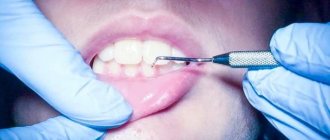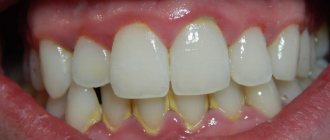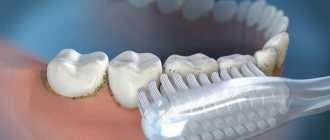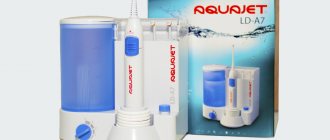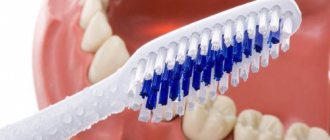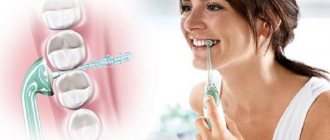Dental deposits are plaque and tartar that form on the surfaces of teeth and accumulate in the supragingival and subgingival space. Dental plaque not only makes our teeth unsightly - dull and yellow, but they contribute to the development of a wide variety of dental diseases of the teeth and gums. It is for this reason that it is imperative to remove dental plaque and do it in the dentist’s office, using professional techniques and equipment.
How dental plaque is removed in dentistry, by what methods and what is the price for the service in Moscow - we will answer all these questions in detail in this article.
Operating principle of ultrasonic cleaning
Tartar removal using ultrasound is based on the destructive effect of high-frequency waves on hard deposits. The procedure is carried out using a special attachment - a scaler.
The directed action of the waves explains the fact that the stone practically crumbles before our eyes, turning into powder. The simultaneous supply of water washes away plaque and cools the tooth, relieving discomfort.
The main advantage of the method is that using a scaler you can clean subgingival pockets. Laser and chemical cleaning do not provide this opportunity.
Another important point is the bactericidal effect. Under the influence of ultrasonic waves, pathogenic bacteria that cause dental damage and oral diseases die.
Causes of dental plaque
Eating is the main cause of plaque formation. Regular brushing of teeth, although it saves you from the appearance of deposits, does not last long. It is enough for food particles to stay on the teeth for 4 hours to lay the foundation for plaque to appear. An effective solution to the problem is the use of dental floss and special rinses. However, with the help of these products it is not always possible to treat the entire oral cavity (deposits will still accumulate in hard-to-reach places).
In more advanced situations, plaque can be visually identified; this will be indicated by characteristic brown or yellow spots on the teeth. From the moment the soft layer of plaque appears until it turns into tartar, it takes about 4-6 months. If you visit the dentist's office in a timely manner, the problem can be easily eliminated at the first stage.
In addition to food particles, the following factors can lead to the appearance of dental plaque:
- Wrong diet. Here the situation is somewhat broader. For example, eating soft foods too often can contribute to the formation of plaque. Other reasons include the habit of chewing on only one side of the jaw. A brush that is too soft can also cause plaque buildup because it simply won’t be able to completely remove all deposits.
- Use of poor quality hygiene products. The toothpaste and brush should be perfect for you. It is recommended to choose a brush of medium hardness (if the current condition of the teeth allows it).
- Superficial teeth cleaning. As practice shows, most of the plaque falls on hard-to-reach areas of the teeth. When cleaning, try to carefully go over all areas to completely remove all deposits.
Dental calculus is an insidious and very dangerous disease. First, the area of the tooth located above the gum will be affected. Then, if appropriate measures are not taken in time, the infection will spread under the gum. And this, in turn, is fraught with destruction of the neck and root of the tooth. Subgingival tartar can completely destroy the supporting-retaining system of the tooth, provoking the development of periodontal disease and other dental diseases. The most unfavorable outcome in this case is the need to remove the tooth.
Causes of dental plaque
Of course, even the most careful approach to the issue of oral hygiene will not save you from plaque formation, but it will significantly slow down its development. But this is absolutely not scary if you visit the dentist’s office in a timely manner.
Is ultrasonic teeth cleaning harmful?
Hygienic teeth cleaning with ultrasound does not have a negative effect on the human body and is recognized by experts as absolutely harmless. The only thing is that there are a number of restrictions, in the presence of which it is not recommended.
Ultrasonic cleaning is a mandatory procedure before prosthetics, installation of braces and implants. It is also recommended that those suffering from periodontitis visit their dentist or hygienist twice a year.
Signs of tartar:
- visible plaque on the enamel - primarily appears on the inner surface of the teeth, as well as on the root part;
- bad breath in the absence of diseased teeth is explained by the vital activity of pathogenic bacteria;
- inflammation, bleeding, swelling of the gums;
- the appearance of pronounced gingival pockets.
Important. If you notice these signs, you should immediately consult a doctor.
Why are dental deposits dangerous?
In the initial stages, plaque causes absolutely no discomfort. It is for this reason that most patients simply ignore yellow spots on their teeth. Moreover, these stains often appear on the back of the tooth, so they don’t even spoil your smile.
Patients begin to sound the alarm only in advanced stages, when caries has already appeared and tartar has settled deep inside under the gums. As a result, dental tissue begins to deteriorate, inflammatory processes appear, and no medications even help with pain. It is best to prevent these consequences immediately rather than wait for the disease to develop. Moreover, at the first stage, the disease is much easier and cheaper to cure.
Pros and cons of ultrasonic tartar removal
The ultrasonic tartar removal procedure has significant advantages over other methods of teeth cleaning. It is less traumatic than mechanical removal of deposits, and more functional than chemical and laser treatments. After cleaning, the enamel acquires a natural color, which makes it possible to choose an implant or filling as close as possible to the desired shade.
Advantages
In most cases, dentists prefer the ultrasound method. In one procedure, the doctor can completely treat all teeth, including subgingival pockets, which guarantees the most complete removal of hard deposits.
The main advantages of the procedure include:
- high-quality treatment of the tooth surface, including fissures, without damaging the enamel;
- removal of solid deposits even from the most inaccessible places;
- painlessness of the procedure;
- treatment of periodontal pockets;
- bactericidal effect – complete destruction of pathogenic microflora.
It also makes sense to talk about the prevention of caries, periodontitis, inflammatory diseases of the gums and teeth, since well-polished enamel prevents the rapid settling of deposits.
Important. The procedure does not cause allergic reactions, which is especially important for asthmatics and allergy sufferers.
Flaws
Perhaps the only drawback of the procedure is slight pain on sensitive teeth. In such cases, the doctor uses local anesthesia in the form of a gel. The disadvantages include the presence of contraindications for the patient.
Preparation for the procedure
First of all, the specialist examines the client and assesses whether the condition of his teeth and gums meets all the requirements and restrictions of this procedure.
The doctor must ask about any contraindications.
Attention! Since many of them are not detected during examination, pay close attention to the relevant section of the article.
Some clinics use a special safe solution, after applying which the tartar appears on the tooth enamel in a brighter shade. This method makes the specialist’s work easier.
How to clean teeth with ultrasound: stages
Your very first step is to go to the dentist. The doctor will do the rest.
The procedure is carried out in several stages:
- applying an anesthetic gel to the surface of the teeth - if necessary;
- directly removing tartar from enamel;
- treatment of subgingival pockets;
- grinding using special pastes;
- polishing - at the request of the patient.
The stone is removed under the action of a scaler with the simultaneous supply of a stream of water.
Modern techniques involve the use of the Air-Flow method together with ultrasound. After hard deposits have been removed, it is possible to treat the teeth with a water-abrasive mixture under pressure. Microscopic soda crystals penetrate even the interdental spaces, clean hard-to-reach places well, and polish the enamel.
The combined use of ultrasound and Air-Flow ultimately gives excellent results. The surface of the teeth becomes smooth, deposits disappear, the teeth look well-groomed, and the smile becomes beautiful.
Important. You should not uncontrollably (and also under control) rub your teeth with soda powder. In this case, you are guaranteed to have thinning enamel, but the deposits will remain in place.
Where to contact?
At the dental department of the CELT clinic, you can order professional plaque removal services using modern ultrasonic cleaning technology. Deep cleaning of gum pockets and teeth is carried out with a complex “Vector” device. We use effective anesthetics, which we select individually. Contact us! We will make your smile even more beautiful!
Make an appointment through the application or by calling +7 +7 We work every day:
- Monday—Friday: 8.00—20.00
- Saturday: 8.00–18.00
- Sunday is a day off
The nearest metro and MCC stations to the clinic:
- Highway of Enthusiasts or Perovo
- Partisan
- Enthusiast Highway
Driving directions
Is it painful to brush your teeth with ultrasound?
The procedure is considered painless, but may cause some discomfort if the enamel is sensitive. If the patient has a high pain threshold, he may well do without anesthesia. But in most cases, the dentist applies a special gel to the surface of the teeth. Also, applying water to the tooth when exposed to a scaler helps reduce pain.
Stone removal with 20% discount
Moscow
Will my teeth hurt after brushing?
No, no and NO. On the contrary, all patients, without exception, note extraordinary freshness in their mouth after the procedure. If you can say – even a feeling of lightness. The removed deposits do not put pressure on the enamel, and the feeling of tension in the teeth disappears.
When exposed to a scaler and a water-abrasive mixture under pressure, the gums are massaged. Blood circulation is normalized in the soft tissues, which also provides noticeable comfort in the mouth.
In general, ultrasonic cleaning is great. Having done it at least once, you will come to the dentist once every six months as required. Please note, come with pleasure.
Contraindications
A significant drawback of the procedure is the presence of contraindications. The doctor will definitely ask if you have any diseases or orthopedic structures, the presence of which implies a refusal to carry out cleaning.
Contraindications in this case include:
- acute bronchitis, asthma;
- diseases of the heart and blood vessels, installed pacemaker;
- infectious diseases, including ARVI;
- first trimester of pregnancy;
- presence of implants, bridges, braces;
- in a separate line – epilepsy, hepatitis, HIV.
It is also not recommended to perform the procedure on children's baby teeth.
Is it possible to brush teeth with ultrasound during pregnancy?
The best period for preventive cleaning is the second trimester of pregnancy. At this time, the child is already reliably protected by the placenta and is actively developing. Increased growth of the skeletal system provokes tooth decay in the mother, so we must try to protect ourselves as much as possible.
Ultrasonic cleaning with the addition of Air-Flow is considered by experts to be one of the best methods of prevention, as it allows you to sanitize the oral cavity as effectively as possible. The risk of caries is reduced, which allows you to simply save your teeth.
Before visiting a dentist, you must obtain permission from a gynecologist, since the decision is made individually, based on the woman’s condition.
Important. Ultrasound does not affect mother and child and does not cause allergies. The procedure is painless, and the mother feels excellent after the session.
Prevention
Preventing the appearance of dental plaque is quite simple and useful. It provides the following:
- Regular oral hygiene procedures in the morning and evening for three to five minutes;
- Preventive visits to the dentist every six months;
- The use of special toothpastes that remove plaque well;
- Using floss to remove food debris between teeth;
- Rinsing your mouth after every meal;
- Reducing the consumption of sweet and starchy foods, which create a favorable environment for the proliferation of pathogenic microorganisms;
- Eating fresh fruits and vegetables.
Photos before and after ultrasonic teeth cleaning
Author: Elena Kopylova Dentist-therapist, endodontist. Work experience more than 8 years. The information is for reference only. Before treatment, consultation with a doctor is necessary.
